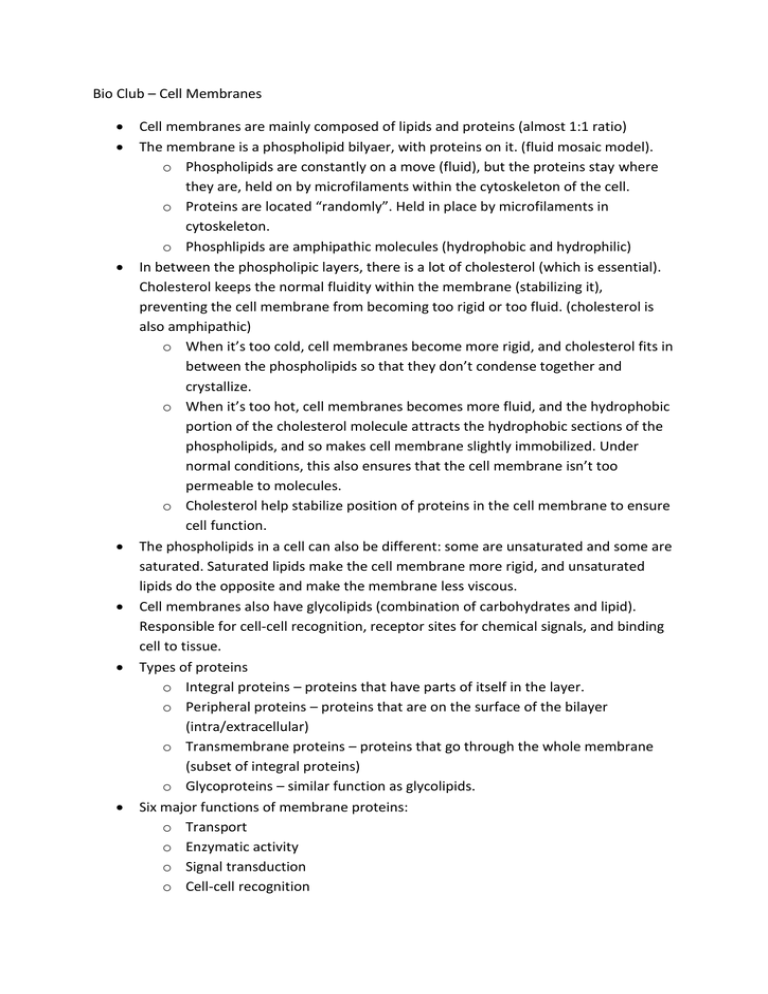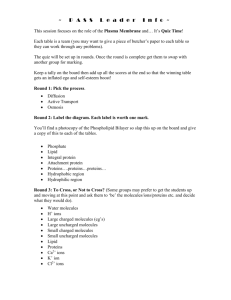Bio Club – Cell Membranes Cell membranes are mainly composed
advertisement

Bio Club – Cell Membranes Cell membranes are mainly composed of lipids and proteins (almost 1:1 ratio) The membrane is a phospholipid bilyaer, with proteins on it. (fluid mosaic model). o Phospholipids are constantly on a move (fluid), but the proteins stay where they are, held on by microfilaments within the cytoskeleton of the cell. o Proteins are located “randomly”. Held in place by microfilaments in cytoskeleton. o Phosphlipids are amphipathic molecules (hydrophobic and hydrophilic) In between the phospholipic layers, there is a lot of cholesterol (which is essential). Cholesterol keeps the normal fluidity within the membrane (stabilizing it), preventing the cell membrane from becoming too rigid or too fluid. (cholesterol is also amphipathic) o When it’s too cold, cell membranes become more rigid, and cholesterol fits in between the phospholipids so that they don’t condense together and crystallize. o When it’s too hot, cell membranes becomes more fluid, and the hydrophobic portion of the cholesterol molecule attracts the hydrophobic sections of the phospholipids, and so makes cell membrane slightly immobilized. Under normal conditions, this also ensures that the cell membrane isn’t too permeable to molecules. o Cholesterol help stabilize position of proteins in the cell membrane to ensure cell function. The phospholipids in a cell can also be different: some are unsaturated and some are saturated. Saturated lipids make the cell membrane more rigid, and unsaturated lipids do the opposite and make the membrane less viscous. Cell membranes also have glycolipids (combination of carbohydrates and lipid). Responsible for cell-cell recognition, receptor sites for chemical signals, and binding cell to tissue. Types of proteins o Integral proteins – proteins that have parts of itself in the layer. o Peripheral proteins – proteins that are on the surface of the bilayer (intra/extracellular) o Transmembrane proteins – proteins that go through the whole membrane (subset of integral proteins) o Glycoproteins – similar function as glycolipids. Six major functions of membrane proteins: o Transport o Enzymatic activity o Signal transduction o Cell-cell recognition o Intercellular joining o Attachment to cytoskeleton and extracellular matrix (structural support to animal cells ) There are three main methods for transport: passive transport, active transport and bulk transport. Passive transport o Passive transport means that no work needs to be done by the organism to carry out the transport mechanism. o In diffusion, molecules move through a concentration gradient (two regions with different concentrations). This happens due to the kinetic nature of molecules – molecules move in random motion, and generally moves from a high concentration to a low concentration until equilibrium is reached. o In order to pass through the phospholipid bilayer directly, the molecule must be small and hydrophobic (non-polar). This is because in the middle of the bilayer, the tails of the phospholipids are non-polar. Examples include Carbon Dioxide, Oxygen. o And so these small hydrophobic pass through the membrane via diffusion. o For hydrophilic molecules (polar molecules), they pass through the membrane through facilitated diffusion. Facilitated diffusion is carried out by integral proteins that have pores through the middle (channel proteins for smaller ions or polar molecules; carrier proteins for bigger molecules). These pores open in the presence of the substrate, and the molecules move through concentration gradient. Despite the name, this is not diffusion. No energy is required. Examples include glucose and small ions o Osmosis is a special case of facilitated diffusion. Osmosis is the passive movement of water molecules, across a partially permeable membrane, from a higher to lower concentration of water molecules (or lower to higher concentration of solute). No energy is required. Active transport o Most of the time cells require substances that are from outside of the cell, even when the concentration of that substance is greater within the cell. Diffusion cannot happen since molecules do not move from a lower concentration to a higher concentration naturally. o Therefore, active transport is required to bring these molecules into the cell. Active transport is a process that requires metabolic energy from the cell, in the form of ATP. o Active transport has these characteristics: Active transport works against a concentration gradient. This means that molecules move from a region of low concentration to high concentration. Normally, within the cell there are some ions and molecules that are useful to the cell (e.g. Nitrate ions in plant cells) and these do not escape the cell. However, when more of the substrate is available outside the cell, the cell takes in these molecules and ions via active transport. Active transport is a highly selective process. Cells choose which ion or molecule to uptake based on what is needed. For example, in plants, if sodium nitrate is available for absorption, the plant cell will take in more nitrate ions than sodium ions. Active transport involves special integral proteins called pump proteins. The pump mechanism is activated by the reaction of the protein with ATP; ATP supplies the energy for the pump to open and close. o Sometimes these pump proteins (or pump molecules) can work in one direction, or transport two different molecules in two different directions. o Most common example of two direction active transport: Sodium and Potassium ions pump. ATP from within the cell is joined to the pump protein to activate the pump. Sodium ions are loaded to the pump from within the cell. Protein pumps the sodium ions out of the cell. In this process the ATP that was joined becomes ADP + Pi, and the Phosphate ion stays joined to the protein. Potassium ions are loaded into the protein, and protein transports potassium ions into the cell. At this time the phosphate ion is released, and the entire process repeats again. Bulk Transport o Bulk transport is used to transport big pieces of matter in vesicles in and out of the cell. This applies for both solids and liquids. Movement into the cell is called endocytosis, and movement out of the cell is called exocytosis. o Bulk transport is possible due to the cell membrane’s strength and fluidity. o There are two types of endocytosis: for solids, it’s called phagocytosis. For liquids, it’s called pinocytosis. o The vesicle of matter first touch the cell membrane when it goes in, and then the cell membrane pulls inward, sucking in the vesicle into the cell. Example: macrophages – cells that digest damaged cells or bacteria. o In exocytosis, it’s the same but in the opposite direction. This is how chemicals and proteins from rough endoplasmic reticulum and Golgi apparatus are transported out of the cell.






